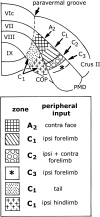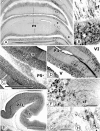The distribution of climbing and mossy fiber collateral branches from the copula pyramidis and the paramedian lobule: congruence of climbing fiber cortical zones and the pattern of zebrin banding within the rat cerebellum
- PMID: 12805304
- PMCID: PMC6740790
- DOI: 10.1523/JNEUROSCI.23-11-04645.2003
The distribution of climbing and mossy fiber collateral branches from the copula pyramidis and the paramedian lobule: congruence of climbing fiber cortical zones and the pattern of zebrin banding within the rat cerebellum
Abstract
Individual cerebellar cortical zones defined by the somatotopy of climbing fiber responses and by their olivo-cortico-nuclear connections located in the paramedian lobule and the copula pyramidis of the rat cerebellum were microinjected with cholera toxin B subunit. Collateral branches of climbing and mossy fibers were mapped and related to the pattern of zebrin-positive and -negative bands of Purkinje cells. Climbing fiber collaterals from the copula distribute to the anterior lobe: from the paramedian lobule mainly to lobulus simplex and rostral crus I. Climbing fibers terminating in particular zones (X, A2, C1, CX, C2, C3, D1, and D2) in the paramedian lobule or the copula collateralize to one or two corresponding zones in lobulus simplex, crus I and II, the paraflocculus, and/or the anterior lobe. These zones can be defined by their relationship to the pattern of zebrin banding. Collaterals from mossy fibers, labeled from the same injection sites in the copula and paramedian lobule, often distribute bilaterally in a symmetrical pattern of multiple but ill-defined longitudinal strips in the anterior lobe and/or lobulus simplex. One or more of these longitudinal aggregates of mossy fiber collaterals was always found subjacent to the strip(s) of labeled climbing fiber collaterals arising from the same locus in the paramedian lobule or the copula. Corticonuclear projections focused on the target nucleus of each zone, although a bilateral plexus of thinner axons, presumably of mossy fiber collateral origin, was sometimes also present in several other regions of the cerebellar nuclei. Overall, these results suggest that climbing fiber zones and zebrin banding reflect a common organizational scheme within the cerebellar cortex.
Figures







Similar articles
-
Precise spatial relationships between mossy fibers and climbing fibers in rat cerebellar cortical zones.J Neurosci. 2006 Nov 15;26(46):12067-80. doi: 10.1523/JNEUROSCI.2905-06.2006. J Neurosci. 2006. PMID: 17108180 Free PMC article.
-
Somatotopical organisation within the climbing fibre projection to the paramedian lobule and copula pyramidis of the rat cerebellum.J Comp Neurol. 1997 Dec 15;389(2):249-63. J Comp Neurol. 1997. PMID: 9416920
-
Organization of pontocerebellar projections to identified climbing fiber zones in the rat.J Comp Neurol. 2006 Jun 1;496(4):513-28. doi: 10.1002/cne.20940. J Comp Neurol. 2006. PMID: 16572464
-
Branching patterns of olivocerebellar axons in relation to the compartmental organization of the cerebellum.Front Neural Circuits. 2013 Feb 4;7:3. doi: 10.3389/fncir.2013.00003. eCollection 2013. Front Neural Circuits. 2013. PMID: 23382711 Free PMC article. Review.
-
Identification of the Purkinje cell/climbing fiber zone and its target neurons responsible for eye-movement control by the cerebellar flocculus.Brain Res Brain Res Rev. 1991 Jan-Apr;16(1):39-64. doi: 10.1016/0165-0173(91)90019-5. Brain Res Brain Res Rev. 1991. PMID: 1863816 Review.
Cited by
-
Spontaneous activity signatures of morphologically identified interneurons in the vestibulocerebellum.J Neurosci. 2011 Jan 12;31(2):712-24. doi: 10.1523/JNEUROSCI.1959-10.2011. J Neurosci. 2011. PMID: 21228180 Free PMC article.
-
Rebuilding cerebellar network computations from cellular neurophysiology.Front Cell Neurosci. 2010 Nov 4;4:131. doi: 10.3389/fncel.2010.00131. eCollection 2010. Front Cell Neurosci. 2010. PMID: 21103017 Free PMC article. No abstract available.
-
Compartmentation of the cerebellar cortex: adaptation to lifestyle in the star-nosed mole Condylura cristata.Cerebellum. 2015 Apr;14(2):106-18. doi: 10.1007/s12311-014-0618-8. Cerebellum. 2015. PMID: 25337886
-
Beyond "all-or-nothing" climbing fibers: graded representation of teaching signals in Purkinje cells.Front Neural Circuits. 2013 Jul 2;7:115. doi: 10.3389/fncir.2013.00115. eCollection 2013. Front Neural Circuits. 2013. PMID: 23847473 Free PMC article. Review.
-
Modulation of Purkinje cell complex spike waveform by synchrony levels in the olivocerebellar system.Front Syst Neurosci. 2014 Oct 30;8:210. doi: 10.3389/fnsys.2014.00210. eCollection 2014. Front Syst Neurosci. 2014. PMID: 25400556 Free PMC article.
References
-
- Apps R ( 2000) Rostrocaudal branching within the climbing fibre projection to forelimb-receiving areas of the cerebellar cortical C1 zone. J Comp Neurol 419: 193–204. - PubMed
-
- Apps R, Trott JR, Dietrichs E ( 1991) A study of branching in the projection from the inferior olive to the x and lateral c1 zones of the cat cerebellum using a combined electrophysiological and retrograde fluorescent double-labelling technique. Exp Brain Res 871: 141–152. - PubMed
-
- Armstrong DM, Harvey RJ, Schild RF ( 1973a) The spatial organisation of climbing fibre branching in the cat cerebellum. Exp Brain Res 18: 40–58. - PubMed
-
- Armstrong DM, Harvey RJ, Schild RF ( 1973b) Branching of inferior olivary axons to terminate in different folia, lobules or lobes of the cerebellum. Brain Res 54: 365–371. - PubMed
-
- Atkins MJ, Apps R ( 1997) Somatotopical organisation within the climbing fibre projection to paramedian lobule and copula pyramidis of the rat cerebellum. J Comp Neurol 389: 249–263. - PubMed
Publication types
MeSH terms
Substances
LinkOut - more resources
Full Text Sources
Miscellaneous
